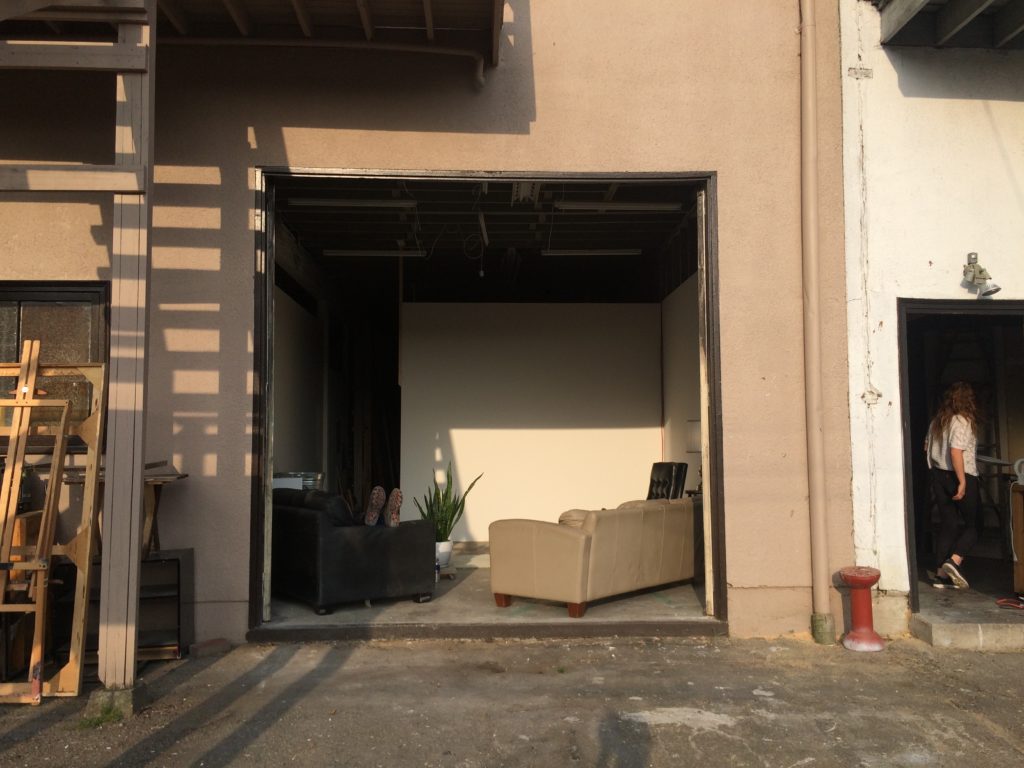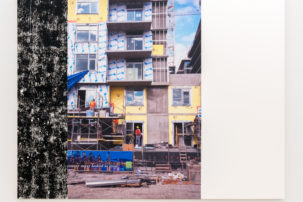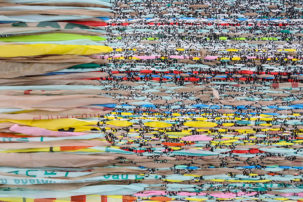In the first part of this series, I proposed the question, “Who has a right to art?” Over the course of my writing and reporting, this idea, which struck me so vividly, has distilled into an even more fundamental query: Do artists have a right to make art?
Speaking with members of the art-studio collective Duplex, it was artist Kara Hansen who pointed out (with some hesitation) what she sees at an inherent problem running through the basis of my reporting: “Being a first wave gentrifier is definitely an issue, but it’s interesting to focus a series on affordability affecting artists, when we can afford not one but two spaces,” Hansen says, referring to the collective’s Fraser Street studios. “I think outside of my art practice—and myself, I volunteer for the VTU [Vancouver Tenants Union]. It’s problematic to talk about how we are affected.”
Hansen’s concern is grounded. Reportage from the New York Times in 2017 showed that 40 per cent of urban-dwelling 22–24 year olds receive money from their parents, with those in art and design fields receiving the most supplemental funds, motioning to both the axis of privilege and measly incomes. And it is true, as discussed previously, that there are people much more acutely affected by the rich and powerful who play with Vancouver real estate like casino chips. But following this logic leads to a flawed, fundamentalist point of view. Artists, like all other workers in our service economy, need space to do their work. The time and space to create work, and to experiment, without reason, should not be viewed as a luxury. Artists studios are more than a space to make and house art; historically artist studios have been monumental in creating a supportive community of artists. And in an industry whose communities are so often affected by mental health issues, such support is essential.
In the non-art world, studio space is a big money-maker. Mega workspace collectives, such as WeWork, have manifestos to reconfigure how we view our lives and our work: a coherent whole where satisfaction comes from being a freelance entrepreneur and #doingwhatyoulove. What WeWork sells, more than space, is culture, the promise of a community of like-minded creatives who are able to work autonomously, but share in a community. Beyond their corporate promises and networking opportunities, WeWork speaks to a growing desire for connection in the gig and creative economy. In many ways, WeWork has been able to commodify a version of culture that artist studios and DIY spaces have spent decades nurturing and protecting while trying to scrape by.
Many artists who are not drawing significant funds from their art practice find opportunities for affordable space limited to DIY spaces, which I define here as independent artist-run studios and music venues, and collective exhibition spaces. These spaces often operate under the eye of the larger, more public-facing cultural institutions such as government-funded artist-run centres or street-facing commercial galleries. Vancouver, like many other cities, has a long history of DIY spaces serving as incubators, where experimentation is of value and where collective communities are able to support one another through independent leadership—all with low overheads being critical to their longevity. And Vancouver’s DIY spaces are under threat, one that is felt across larger North American cities, due to increasing rents and operational costs (property taxes, regulatory fees, maintenance and safety expenses).
In a 2019 piece for VICE by Caroline Lewis, which looked at the economic sustainability of DIY music studios in the United States, Joe Ahearn, a Brooklyn community-organizer and co-founder of alternative space startup WithFriends, voiced concerns over the long-term goals of such spaces: “I’m less worried about how someone runs a space for one or two years in the current climate and more worried about how someone builds a decades-long, multi-generational arts community.”
One of Vancouver’s longest-running DIY spaces, Red Gate Arts Society, has been bridled with securing affordable, long-term space since its inception in 1984. Most recently Red Gate (which comprises artist and musician studios and a performance venue) was forced out of its East Hastings space when the building was purchased by Chip Wilson’s Low Tide Properties and the space underwent a significant rent increase. According to Red Gate co-founder and society director Jim Carrico, rent tripled. “Generally, cultural space needs to be recognized, and it’s a desperate emergency in Vancouver, equivalent to vanishing rainforests, or these kinds of things, in the sense that once it’s gone, it’s gone. People are hanging on with their fingernails.” Just this month, in an all-too familiar story, jazz club Merge and dance music venue Index—both bastions of Vancouver’s underground music scene—were forced out of their 1305 Powell Street location after being “renovicted” by Low Tide Properties.
The narrative is not a new one—DIY studios open, close and are replaced by another. “The culture that sort of enables the events that we do, there’s almost a transient economy,” says Robin Selk, co-director of Deep Blue studios, along with Jean Brazeau. “Places open up and become the new hot spot just because you found your new spot.” Like most DIY spaces, Deep Blue, which hosts both electronic artists studios as well as a performance space, allocates no income for its workers. Instead, excess funds are used to pay artist performance fees and to bring out-of-town artists to perform. But rising operating costs, like rising property taxes, is biting into those funds. “Our landlord is super supportive of us and our agreement is that we pay very little rent, but in exchange we have to pay the property tax,” Brazeau says. “And every year it gets more and more expensive and every year we have had to build more studios.”
The pressure is on even for Vancouver’s more officially established organizations. Take for example the Eastside Culture Crawl, an annual arts and crafts festival that tours East Vancouver and includes Parker Street Studios, a 52,000-square-foot artist space housing 110 studios. “A couple years ago you could find some other spaces, but space has become such a challenging thing to find, and to find something that is affordable is next to impossible,” says executive director Esther Rausenberg. Rausenberg notes one such recent closing, the exhibition and studio space The Bakery. “In the case of The Bakery, it’s [closing because of] development. I’m assuming given the nature of the building that it is going to be torn down and something else will be put in its place,” she says. “There’s a lot of pressure in the limited industrial lands that we have here in Vancouver.”
That pressure is partly due to the aforementioned property taxes, but also to developers’ new-found interest in property farther and farther east in the city. The Eastside Culture Crawl receives financial support from a number of local businesses: four out of thirteen of those listed on their website are development companies or real estate firms, including development group Beedie. Parker Street Studios is owned by Beedie, which also features the studios on marketing material and in its social media posts. It’s not an unusual agreement—cultural organizations accepting development support—but in such a quickly changing neighbourhood, the developer’s motives seem thinly veiled. In supporting organizations like Parker Street Studios (which favours commercially viable artist practices such as sculpture and painting), Beedie and other development companies can point to their limited support while simultaneously dismantling artists communities.
Red Gate was able to relocate to a new space, this time in the heart of condo-developing Main Street. In an effort to secure a new space, Red Gate recently became a not-for-profit organization, but Carrico is suspicious of government funding as well as wary of the red tape that can hinder art spaces like Red Gate. “It’s been a very difficult job describing [Red Gate]. Bureaucracies have a hard time wrapping their head around the need for spontaneous activity where you don’t know what the result will be and you don’t know what your target is,” he says. “It’s really hard to explain that to people who live in highly structured, institutional environments.” Besides the labour associated with grant funding applications, as well as access to limited city resources, government funding is mostly antithetical to the DIY community ethos. “The rewards far outweigh the downsides, except for the fact that I have no money,” Carrico jokes dryly. “But I certainly have a life. I don’t need to watch HBO drama series because I have way more drama in my real life.”
With space for artists in Vancouver a privileged resource, historically disadvantaged communities face more than economic barriers to entry. When looking for more affordable studio spaces (such as independent DIY studios), Indigenous artists face systemic and direct racism in these largely white-lead communities. Whess Harman, a trans/non-binary queer/2SQ artist from the Carrier Witat, Lake Babine Nation, has been involved in community organizing and independent studios such as the Gam Gallery/Acme Studios in Vancouver’s Downtown Eastside. Harmen describes their experience at the Gam (lead by a writer and curator Tarah Hogue, who is of Métis/French Canadian and Dutch ancestry), shortly after graduating from Emily Carr University of Art and Design, as a place where navigating a mostly white space became taxing. “I kind of found that at the Gam—even though it was run by Tarah Hogue and her friend at the time, and I did have someone Indigenous helping run it—the space itself was largely white, which didn’t always make for the best dynamic,” Harman says. “I had just gotten out of school and I didn’t have the confidence to approach everything that I didn’t like about the space, and I didn’t really feel like I could stand my ground.”
A lack of non-white leadership in independent artist spaces and DIY communities creates not only hostile and emotionally laborious spaces, but also keeps communities insular. “One of the conversations that comes up a lot with my friends [is about how] we’re excited to have Indigenous-organized events…. We just did ‘Together Apart’ at grunt gallery, which was the Two-Spirit/Indigiqueer symposium that happened over three days,” Harman reflects. “We’re excited to have those spaces but they’re kind of few and far between. It does feel strange to always have to corral under Indigenous art. We’re not often being invited to things outside of Indigenous art and [we’re] being blended in with other programs.” Harman, who is currently in residence at the Skwachàys Lodge, recognizes the steps that DIY spaces have been making toward a more inclusive environment. “You look at programming at Red Gate, which does really amazing work, but it’s only very recently that I’ve heard bands starting to acknowledge the unceded territories that they’re performing on,” they say.
Vancouver’s DIY community has been active in addressing other social issues present within their constructs, including the reality of artists gentrifying communities. Organizations such as Duplex are aware of their role within gentrification and are taking proactive steps to disrupt the process. Duplex is located on the southern end of Fraser Street, a neighbourhood that is being quickly redeveloped. “I think one of the ways that we’re attempting to handle this is being really good about the space we have and engaging with this level of privilege that we have, but also trying to put into the community as much as we can without taking up a presence and becoming a force,” says Duplex member Liam Johnstone. “[Not having] a street-facing location, having a back-alley entrance, and keeping with that, are maybe some of the ways that we are trying to manage this in our own way.” The members of Duplex cite community communication as its most valuable tool in working towards being neighbours, rather than early gentrifiers.
Even still, Duplex’s presence on Fraser Street may be short-lived. The studio’s current lease is up in September 2019 and the collective has been offered a new lease from their new landlord with a roughly 216 percent increase in rent. At the time of publication, Duplex is in the process of drafting a counter-offer.
What Vancouver is in danger of losing, beyond just space for artists to work, is the butterfly effect that ripples throughout the arts. It’s not just safe, affordable spaces for artists to work that are disappearing, but also the communities that form around them. Even the very spaces these kinds of organizations often operate out of have cultural value. As Selk of Deep Blue explains, “There is a kind of characteristic of the space, and it is related to the types or forms of art that are being produced, and the culture that exists around the studio and the artists that we bring in, and the music and the scenes that they are referencing,” he says. “That’s not to say that without these kinds of spaces it won’t exist, but it will fundamentally be heard differently and maybe the modes of production, the type of output that you produce will change in a spatial consideration.” Inherent to the DIY space may be ephemerality, but in its fleeting presence it provides an authenticity that refuses to be commodified.

 Exterior view of Vancouver DIY gallery and artist-run studio space Duplex. Courtesy Duplex.
Exterior view of Vancouver DIY gallery and artist-run studio space Duplex. Courtesy Duplex.







